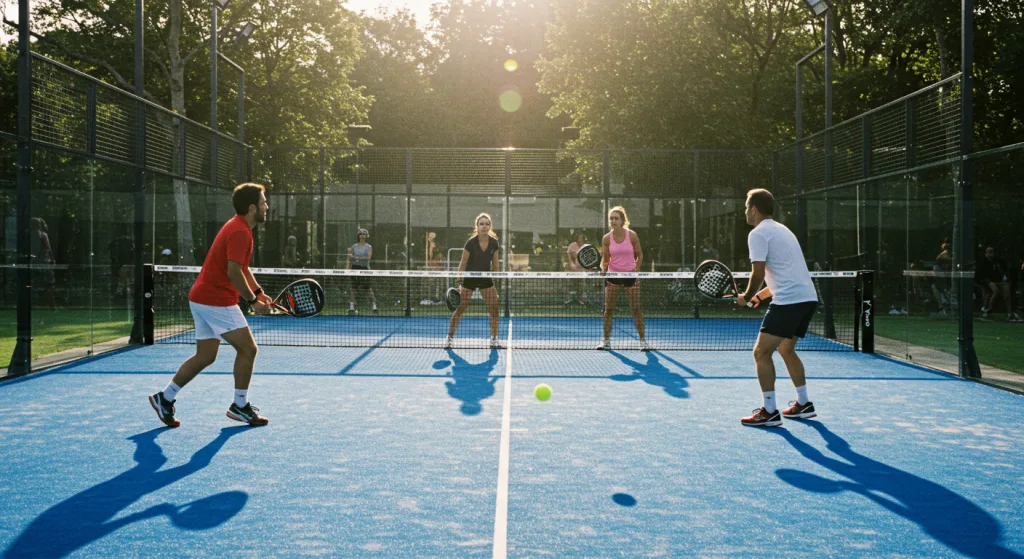Padel has become one of the fastest-growing sports worldwide and here in the UK with more courts appearing all the time. While it offers excellent exercise and social benefits, players should be aware of common injuries associated with this dynamic sport.
What injuries are common in padel?
Padel combines quick movements, repetitive actions, and explosive power, creating perfect conditions for specific types of injuries. The most frequently seen problems affect the elbow, knee, shoulder, lower back, and feet.
Elbow injuries top the list, accounting for approximately 20% of all padel-related injuries, according to research published in sports medicine journals. Tennis elbow (lateral epicondylitis) is particularly prevalent among novice players who haven’t yet mastered proper technique.
The overall injury rate stands at about 3 injuries per 1000 training hours and increases to 8 per 1000 match hours. Studies show that between 40% and 95% of regular players experience some form of injury, with tendon and muscle problems being most frequent.
Let’s examine each major injury type in detail:
Elbow injuries in padel players
- Lateral epicondylitis (tennis elbow) – caused by repetitive microtrauma to forearm extensor tendons
- Extensor tendinopathy – overuse of the extensor carpi radialis brevis tendon
- Pain typically located on the outside of the elbow
- Often worse when gripping the racket or during backhand strokes
Tennis elbow develops from a combination of poor technique, equipment issues, and overuse. Many beginners hit backhand strokes with excessive wrist flexion, which places tremendous strain on the tendons attaching to the lateral epicondyle.
Vibration from racket impact contributes significantly to this problem. Studies from BMJ Open Sport & Exercise Medicine show that players using rackets with inadequate shock absorption face higher risks.
Treatment typically involves rest, ice application, anti-inflammatory measures, and gradual return to play with corrected technique. In persistent cases, physiotherapy, specific exercises, or even specialised treatments like shockwave therapy might be necessary.
How do knee injuries affect padel players?
Padel demands frequent direction changes, jumps, and sudden stops – movements that place substantial stress on the knees. Key knee problems include:
- Patellar tendinopathy (jumper’s knee) – inflammation of the tendon connecting the kneecap to the shinbone
- Meniscus damage – tears to the cartilage cushioning the knee joint
- Medial collateral ligament (MCL) injuries – stretching or tearing of the ligament on the inner knee
Male players experience jumper’s knee more frequently, while female players have higher rates of chondromalacia patellae (softening of the cartilage under the kneecap) due to anatomical differences.
Prevention focuses on proper warm-up, strengthening exercises, and appropriate footwear. Players should also develop court movement techniques that minimise sudden twisting motions under load.
Shoulder problems from playing padel
The overhead motions in padel, particularly smashes, create significant stress on the shoulder complex. Common issues include:
- Rotator cuff injuries – tears or inflammation of the muscles stabilising the shoulder
- SLAP lesions – tears to the ring of cartilage (labrum) surrounding the shoulder socket
- Impingement syndrome – pinching of tendons between bones during arm movement
These problems often stem from muscular imbalances between stronger muscles like the deltoid and the smaller rotator cuff muscles.
Treatment involves rest from aggravating activities, anti-inflammatory measures, and progressive rehabilitation exercises. Preventative strength training should focus on external rotation exercises and scapular stabilisation.
Why does padel cause lower back pain?
Lower back pain affects many padel players due to:
- Rotational forces during swinging motions
- Rapid changes in position while reaching for balls
- Inadequate core strength
- Poor technique, especially during overhead shots
The twisting movements combined with forward bending place significant stress on spinal joints and muscles. Players who lack proper core stability face higher risks.
Back pain prevention should include core strengthening exercises, proper warm-up routines, and technique adjustments that minimise extreme spinal positions.
Foot and ankle injuries on the padel court
The feet absorb tremendous forces during padel play. Primary foot problems include:
- Plantar fasciitis – inflammation of the tissue band running along the foot sole
- Achilles tendinopathy – inflammation of the large tendon connecting calf muscles to the heel
- Ankle sprains – stretching or tearing of ligaments supporting the ankle
These issues often result from inadequate footwear, excessive training, or insufficient recovery time.
Less common but serious padel injuries
While less frequent, these injuries can cause significant playing time loss:
- “Tennis leg” – calf muscle tear typically occurring during pushing off or jumping, more common in players over 40
- Eye trauma – direct ball impacts at speeds reaching 190 km/h
- Wrist injuries – sprains or tendinitis from racket handling and ball impact
Eye protection deserves special mention, as balls can reach speeds making reaction impossible. Protective eyewear is strongly recommended, especially for doubles play where close-range impacts are more likely.
How can padel players prevent injuries?
Prevention strategies should form part of every player’s routine:
- Proper warm-up: Spend at least 10 minutes on dynamic movements and sport-specific exercises before play
- Equipment selection: Choose rackets with good shock absorption and appropriate weight
- Technique development: Learn correct form for all shots, especially backhand strokes
- Strength training: Focus on core stability, rotator cuff muscles, and lower limb strength
- Recovery management: Allow adequate rest between intense playing sessions
- Footwear: Select court-specific shoes with proper support and cushioning
When should padel players seek professional help?
Seek medical attention if you experience:
- Pain that persists more than 7-10 days despite rest
- Sudden, severe pain during play
- Swelling, bruising, or obvious deformity
- Inability to bear weight or move a joint through its full range
- Numbness, tingling, or weakness
Early intervention often leads to faster recovery and prevents chronic problems from developing. Healthcare professionals can provide appropriate diagnosis, treatment plans, and sport-specific rehabilitation programs.
Conclusion
Padel offers tremendous health and social benefits, but like any sport, it comes with injury risks. Understanding these common problems allows players to implement targeted prevention strategies.
Most padel injuries relate to overuse rather than traumatic incidents, meaning they develop gradually and can often be prevented through proper technique, equipment, and training habits.
If you’re experiencing pain while playing padel, take it seriously. Early management of minor issues can prevent them from developing into chronic problems that might keep you off the court for extended periods.
Remember that staying injury-free requires a balanced approach to training, recovery, and technique development. Listen to your body’s signals and adjust your playing schedule accordingly!












